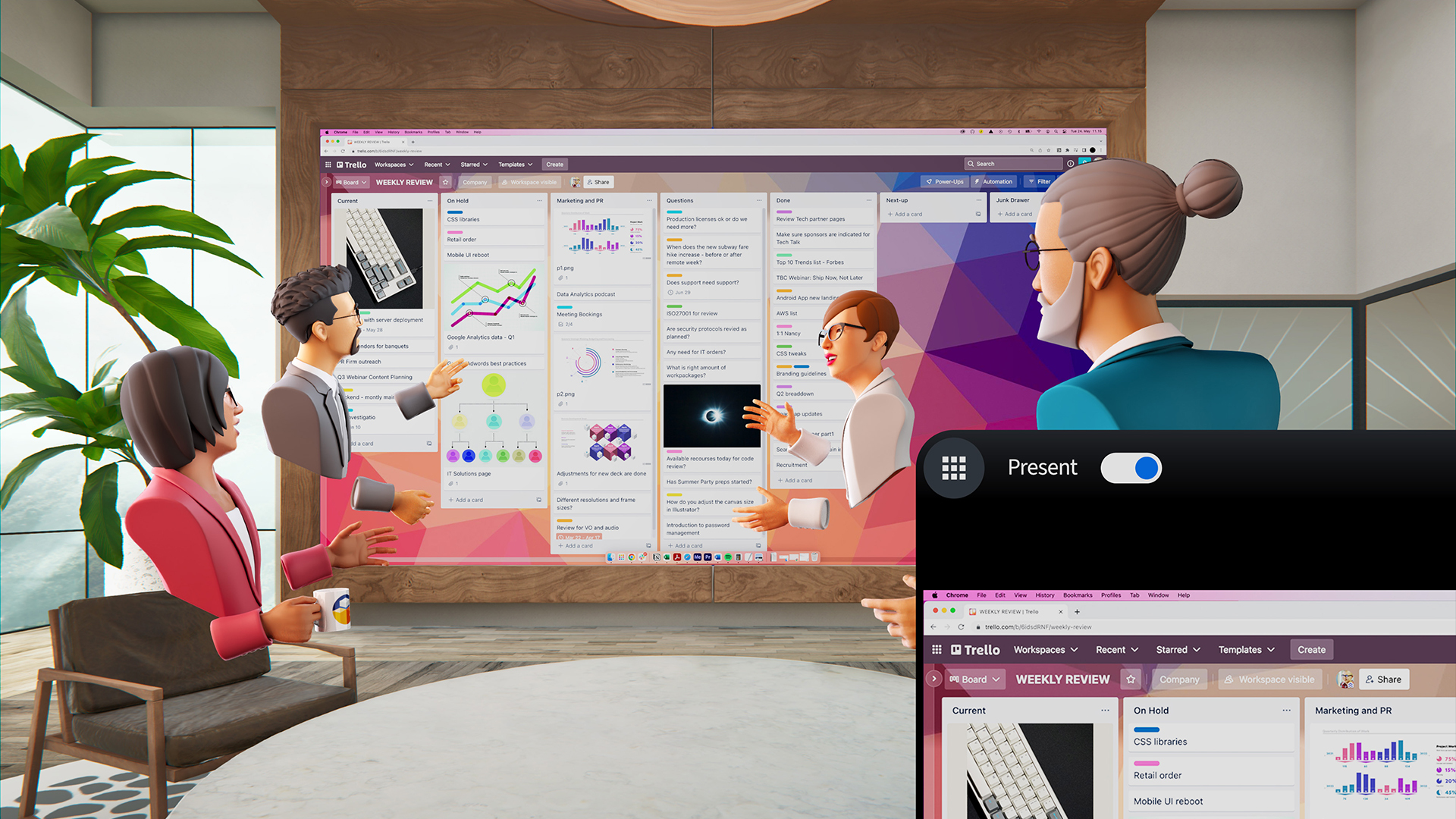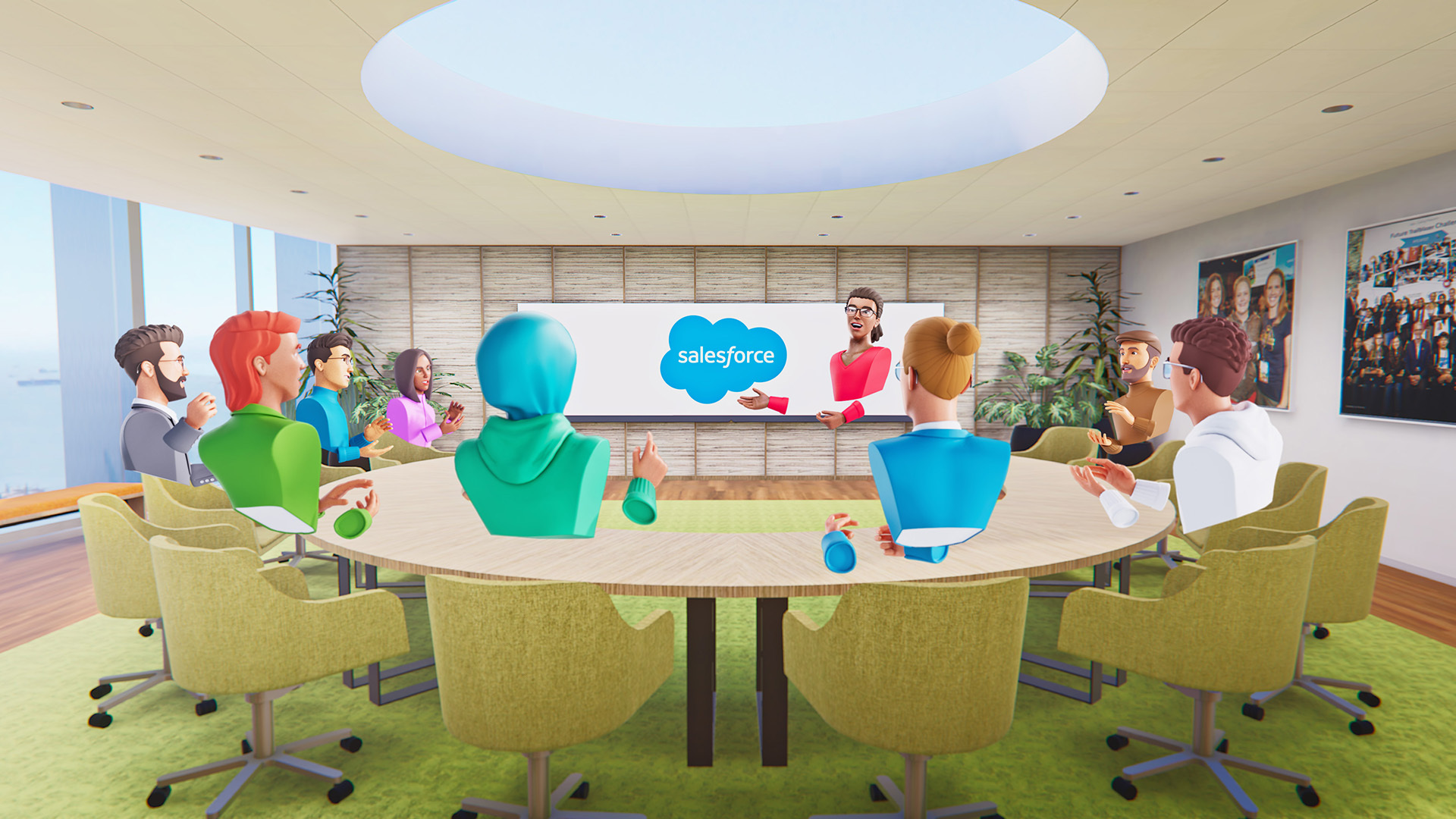
Unlocking the Potential of Virtual Reality Meeting for Business Collaboration
The age of remote work has brought about an unprecedented shift in the way we collaborate, and the potential of virtual reality (VR) in business meetings is now more evident than ever.
Imagine conducting a virtual reality meeting where you can move around, interact with 3D objects, and feel as if you’re in the same room with your colleagues, even if you’re miles apart. This is the power of virtual reality business meetings.
In this blog post, we’ll take a deep dive into the world of virtual reality meetings and how they can make business collaboration better.
Key Takeaways
• Virtual reality (VR) meetings provide enhanced engagement, collaboration and productivity for remote teams.
• Customizable virtual spaces allow businesses to maximize the potential of VR for communication and collaboration.
• Virtual reality meetings offer cost-saving advantages and promote sustainability in the corporate world.

What is a VR meeting?
A VR meeting, also known as a virtual reality meeting, is an immersive, interactive, and collaborative remote meeting that utilizes virtual reality technology, providing a more engaging experience than traditional video conferencing.
Participants wearing VR headsets can navigate and interact in a virtual space, collaborating in real-time using various tools such as virtual whiteboards, notes and 3D models.
VR meetings can range from team gatherings to virtual product demonstrations for customers. Taking place in a ready-made or custom VR space.
The two components of a VR meeting include a VR headset and collaboration software.
Virtual reality headset, such as Meta Quest 2, is a must-have for experiencing the immersive nature of VR meetings. While software applications like Glue provide the necessary tools to host virtual business meetings, events, workshops, and training sessions.
Why do you need VR for meetings?
The advantages of using VR for meetings are numerous. With VR, businesses can:
• Enhance collaboration, and productivity during team meetings
• Improved employees’ training & onboarding experience in comparison with video conferencing
• Offer more immersive and engaging product presentations for customers
• Reduce costs and environmental impact of business travel
• Provide participants with a comprehensive range of interaction options, including enhanced body language, eye contact, and gesturing in real-time etc.
These immersive experiences make virtual meetings more meaningful and productive, fostering stronger connections among participants and enabling more natural human interactions than traditional online meetings.
Understanding VR Meetings
To make the most of VR technology, you need to understand how VR headsets and virtual reality platforms work together.
These two components create immersive virtual environments where remote participants can interact and collaborate in ways that are similar to traditional meetings.
The Role of VR Headsets
Serving as the cornerstone of immersive VR meetings, VR headsets deliver the visual and interactive experiences that bring virtual reality to life. Popular headsets like Pico Neo 4E and Meta Quest 2 offer unparalleled immersion and compatibility with various VR platforms.
These devices allow participants to engage in virtual business meetings with a sense of being in the same room, fostering a stronger connection and presence than traditional video conferencing.
The Role of Software
Another essential component of VR business meetings is collaboration software, as it facilitates seamless communication and interaction among participants.
VR meeting app provides a wide range of tools and features to facilitate effective virtual meetings such as VR whiteboards, notes, importing of 3D models etc. They help foster a stronger sense of connection and comprehension among participants, making virtual collaboration more meaningful, productive and interactive.
Advantages of VR Meetings for Businesses
As mentioned before, virtual reality meetings offer multiple advantages to businesses. Let’s delve deeper and examine them in more detail.
1. Improved Engagement and Collaboration
One of the most significant benefits of virtual reality meetings is their ability to enhance engagement and collaboration. Unlike traditional video conferences, VR meetings provide participants with a more immersive and interactive experience that promotes effective communication and teamwork.
For instance, using virtual whiteboards and 3D models allows participants to work together on projects, brainstorm ideas, and solve problems more efficiently than in traditional video calls.
Scientific research also supports the claim that VR meetings lead to increased engagement.
Various studies have shown that employees in VR meetings are more focused and engaged than those participating in video conferencing. This heightened presence and connection among participants make VR meetings an ideal solution for businesses looking to enhance remote team collaboration. Learn more in our GlueInsights.

2. Custom Virtual Space
Another advantage of meetings in VR is the ability to create custom vr meeting spaces or VR experiences tailored to the specific needs and preferences of businesses.
With a proper virtual reality collaboration platform, businesses can design unique branded meeting spaces that reflect their brand identity, foster creativity, or facilitate specific types of collaboration.
VR environments can range from simulations of the company’s headquarters to dream-like landscapes that inspire creativity and innovation.
The flexibility of virtual environments allows businesses to adapt their meeting spaces for various purposes, such as brainstorming sessions, presentations, or team-building activities.
By providing an engaging and immersive experience, custom virtual environments empower businesses to harness the full potential of VR for remote work. Learn more in our blog on custom virtual spaces.

3. Cost Savings and Sustainability
VR meetings offer advantages to businesses, both in terms of cost savings and sustainability. These savings come from eliminating the need for travel, which cuts expenses related to transportation, accommodations, event venues, and physical event materials.
Furthermore, VR meetings promote sustainability by reducing carbon emissions associated with travel, thus supporting environmentally friendly business practices.
Learn more about how VR provides a powerful option for more sustainable and productive collaboration in our blog.

Use Cases for Virtual Reality Meetings
There are numerous use cases for VR meetings, ranging from remote team collaboration to product demonstrations and virtual tours.
With a clear understanding of VR business applications, businesses can effectively harness the capabilities of virtual reality for remote collaboration.
1. Remote Team Collaboration
One of the primary use cases for VR meetings is remote team collaboration, which fosters closer connections and improved communication among geographically dispersed employees.
Through an immersive and engaging virtual environment, VR meetings help participants feel more connected and present compared to traditional video calls, resulting in enhanced collaboration and teamwork.
By leveraging the power of VR technology, businesses can create unique and engaging virtual spaces such as a virtual reality office that encourage collaboration and strengthen the bonds between team members. Check out how Air-France KLM uses Glue in the video below.
2. Product Demonstrations and Virtual Tours
Another use case for VR meetings is product demonstrations and virtual tours, which enable businesses to showcase their products or services in an immersive and interactive environment.
Leveraging proper VR software, companies can offer customers and stakeholders a virtual experience that transcends the constraints of traditional meetings, thus effectively showcasing their products and processes.
Industries that are likely to benefit the most from product demonstrations and virtual tours in VR meetings include:
• Healthcare
• Education & Training
• Design
• Construction & Manufacturing
• Consulting
By offering these immersive experiences, businesses can engage with prospects in a unique and memorable way, leading to increased interest and sales opportunities. Learn how Konecranes uses Glue in the video below.
3. Training and Workshops
VR meetings can also be used for training, providing engaging and immersive learning experiences for employees. Utilizing the capabilities of virtual reality, businesses can provide hands-on training experiences that promote skill development and knowledge retention.
VR training enables employees to gain knowledge through practical experience, making it an exceptionally efficient training tool.
By incorporating VR technology into their training and development programs, businesses can create more effective and engaging learning experiences for their employees.
Watch the video below to see how Duodecim has integrated health training into their operations.
Implementing VR Meetings in Your Business
Implementing VR meetings in your business involves choosing the right VR meeting platforms, setting up a VR meeting space, and bringing your team to VR.
Understanding the process and choosing the right tools and equipment allows businesses to effectively harness virtual reality’s potential for remote collaboration and communication.
Choosing the Right VR Platform

Choosing a good virtual reality platform is a critical step towards ensuring a smooth and productive virtual meeting experience for your business. Factors to consider when choosing a platform include cost, compatibility, and ease of use.
During the evaluation of VR platforms, you should consider the following aspects:
• Quality of real-time collaboration
• Range of productivity tools
• Security
• Availability of trials, demos and support
By selecting a platform that meets your business’s unique needs and preferences, you can create a more engaging and effective VR meeting experience for your team.
Final Considerations for VR business meetings
Despite the numerous benefits, businesses might encounter certain challenges and limitations while implementing VR business meetings. Addressing issues such as hardware availability, text input, and avatar realism can help businesses fully leverage the potential of virtual reality for remote collaboration.
To overcome these challenges, businesses can provide alternative options for participants who do not have access to VR hardware, such as offering a web-based version of the VR meeting platform that can be accessed via a regular computer or mobile device.
Summary
In conclusion, VR business meetings offer companies a powerful and innovative solution for remote collaboration. With improved engagement and collaboration, customizable virtual environments, and significant cost savings and sustainability benefits, VR meetings can transform the way businesses conduct meetings and interact with their teams.
By understanding the potential of VR meetings and implementing the right tools and strategies, businesses can unlock the full potential of virtual reality for fostering improved business cooperation.
Ready to discover the potential of
VR meetings?
Book a demo to explore VR meetings for your business.

